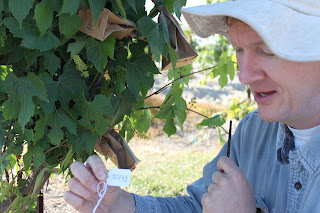Normal raisins on the left, and "sugared" raisins on the right.
Because sugaring is undesirable, raisin packers are interested in understanding the factors that contribute to sugaring so that it may be prevented. The exact cause of crystal formation remains unknown, but a series of studies by L. Peter Christensen, former UC Davis viticulture specialist emeritus, suggest that processing and post-harvest storage conditions have a pronounced influence on the likelihood of sugaring. Christensen showed that one of the most important factors affecting sugaring is raisin moisture content during storage. Raisins stored at 10% to 12% moisture showed little sign of sugaring after one year, but sugaring increased dramatically as moisture content increased beyond 12% such that after one year of storage raisins having 14%, 16%, or 18% moisture, developed crystals on 11%, 28%, or 36% of their surface, respectively. The handling and cleaning of raisins that occurs during processing also seems to increase sugaring problems, but the relative contributions of surface abrasions that may result from destemming, and the increased moisture content that results from washing, is uncertain. The storage of processed raisins under conditions of fluctuating temperature and humidity also favors sugaring. Thus, to reduce the likelihood of sugaring, unprocessed raisins should be dried 14% moisture or less, not processed until necessary, and the gentlest cleaning and processing methods possible should be used.
















